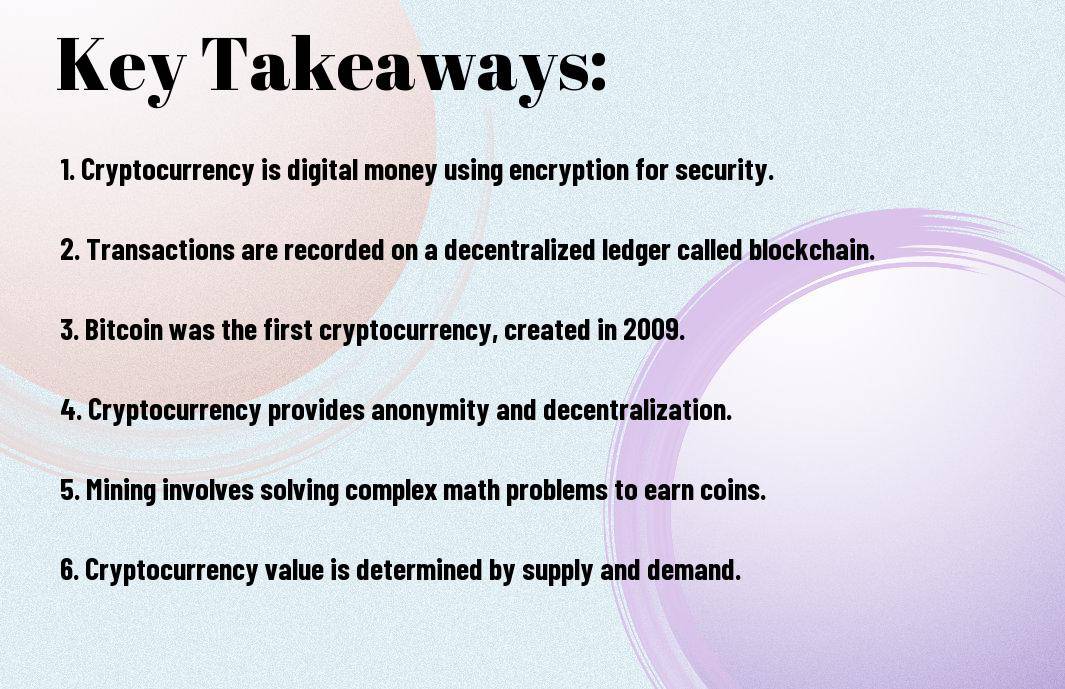
Newsletter Subscribe
Enter your email address below and subscribe to our newsletter

Enter your email address below and subscribe to our newsletter

Decoded: Cryptocurrency has revolutionized the way we perceive and use money. Cryptocurrency is a digital or virtual form of currency that uses cryptography for security, making it nearly impossible to counterfeit. Unlike traditional currencies issued by governments (fiat money), cryptocurrencies operate on decentralized networks based on blockchain technology, a distributed ledger enforced by a network of computers.

Barter: Now, let’s investigate into the evolution of money. In ancient times, people relied on a barter system where goods and services were exchanged for other goods and services. This method had limitations as it required a double coincidence of wants, meaning both parties had to want what the other had to offer.
The transition to modern banking: Over time, the barter system evolved into the use of commodity money such as gold and silver. This eventually led to the development of modern currency and the establishment of banks. Governments began minting coins and issuing paper money, creating a more standardized and widely accepted form of payment.
To: With the advent of the internet and technology, we witnessed the rise of digital currencies. The most notable example is Bitcoin, which introduced the concept of a decentralized cryptocurrency. These digital assets are stored in digital wallets and can be securely transferred between users anywhere in the world, without the need for intermediaries like banks.
Revolution: The digital revolution in the world of money has brought about unprecedented levels of security and privacy through cryptography. However, it has also given rise to concerns such as cybersecurity threats and the potential for illicit activities. Despite these challenges, the positive aspects of digital currencies include instantaneous transactions, lower fees, and financial inclusion for the unbanked population.

Traditional money, such as the US dollar or Euro, is issued and regulated by governments and central banks. It exists in physical forms like cash and digital forms like bank deposits. In contrast, cryptocurrencies are decentralized digital currencies that operate on technology called blockchain. This means that they are not controlled by any central authority, making them immune to government interference or manipulation. Cryptocurrencies can be used for global transactions without the need for intermediaries like banks, resulting in lower fees and faster processing times.
With cryptocurrencies, transactions are recorded on a public ledger called the blockchain, ensuring transparency and security. Each transaction is verified by a network of computers through a process called mining. Cryptocurrencies use cryptography to secure transactions, control the creation of new units, and verify the transfer of assets. Cryptocurrencies also offer anonymity to users, as transactions do not require personal information.
Cryptocurrencies are known for their volatility, with prices capable of fluctuating significantly in a short period. While this volatility can present opportunities for high returns, it also poses risks for investors. Additionally, the decentralized nature of cryptocurrencies means that there is no recourse for lost or stolen funds, as there is no central authority to appeal to for help.

With the rise of cryptocurrencies, it’s crucial to understand the technology that makes them work. At the heart of most cryptocurrencies is blockchain technology. A blockchain is a decentralized and distributed digital ledger that records transactions across a network of computers. Each transaction is added to a block, which is then linked to the previous block, forming a chain of blocks – hence the name blockchain.
This technology ensures transparency, security, and immutability of transactions. When a transaction occurs, it is verified by network participants, encrypted, and added to a block. The information in a block is stored in a way that prevents alteration or deletion, making it a reliable record of transactions.
Mining is the process by which transactions are verified and added to the blockchain. Miners compete to solve complex mathematical problems, and the first one to solve the problem gets to add the next block of transactions to the chain. This process is resource-intensive and requires significant computational power, hence the term ‘mining’.
Blocks contain a list of transactions, a timestamp, and a reference to the previous block. Once a block is added to the blockchain, it is considered immutable. The distributed ledger ensures that each participant in the network has a copy of the blockchain, making it secure and transparent.
For those stepping into the world of cryptocurrency, understanding the different types available is crucial. Here we will explore the two main categories: Bitcoin and Altcoins. Each type has its own unique characteristics and uses within the digital currency space. To learn more about how these cryptocurrencies work, check out How Does Cryptocurrency Work? A Beginner’s Guide.
| Bitcoin: The Original Cryptocurrency | Altcoins and Tokens: Diversity in the Crypto Space |
On January 3, 2009, the mysterious inventor known as Satoshi Nakamoto introduced Bitcoin to the world. It became the first decentralized digital currency operating without a central authority or banks. Bitcoin transactions are recorded on a public ledger called the blockchain, utilizing cryptography to secure them. The total supply of Bitcoin is limited to 21 million coins, making it a deflationary currency.
Types of altcoins and tokens have since emerged, offering unique features and use cases. Altcoins are alternative cryptocurrencies to Bitcoin, such as Ethereum, Ripple, and Litecoin, each with its own blockchain and functionalities. Tokens, on the other hand, represent assets or utilities on existing blockchains. They are commonly used in crowdfunding projects through Initial Coin Offerings (ICOs) and are necessary to the operation of decentralized applications.
The cryptocurrency space continues to evolve with new projects and technologies, providing opportunities for innovation and investment. It is crucial for investors and enthusiasts to stay informed about the risks and rewards associated with different cryptocurrencies and to conduct thorough research before participating in the market. The diversity within the crypto space offers a wide range of options for users, from secure store-of-value assets like Bitcoin to utility tokens powering decentralized ecosystems. Stay updated on the latest developments to make informed decisions in this rapidly changing landscape.
Not all of us are familiar with the intricacies of cryptocurrency and how it functions. To get a better understanding, it’s crucial to grasp the basics before delving into the mechanics of crypto transactions. For a comprehensive guide on the fundamentals of cryptocurrency, The Basics about Cryptocurrency | CTS provides valuable insights.
For those new to the crypto world, one of the initial steps is setting up a digital wallet to store and manage your cryptocurrency. It’s crucial to choose a reliable wallet that offers security features to safeguard your assets. By following the instructions provided by your chosen wallet provider, you can create a wallet address, which acts as your unique identifier in the network.
With the evolution of technology and the rise of digital currencies, the process of transacting with cryptocurrency has become more streamlined and efficient. Individuals can now send and receive funds globally without the need for traditional banking systems. The use of cryptographic principles ensures that transactions are secure and transparent.
Cryptocurrency transactions are known for their security and immutability. Once a transaction is validated and added to the blockchain, it cannot be altered or reversed, making it a trusted means of conducting financial transactions. However, it’s important to exercise caution and adhere to best practices to prevent falling victim to cyber threats and scams within the crypto space.

On a day-to-day basis, the use of cryptocurrency is becoming more common. Many online and even some physical stores now accept various cryptocurrencies as a form of payment. This means that you can buy goods and services, book flights, or even donate to charity using cryptocurrencies like Bitcoin, Ethereum, or Litecoin. The transactions are usually quick and can be done from anywhere in the world, making them convenient for global transactions.
With the increasing adoption of cryptocurrencies, some countries are starting to explore the idea of creating their own digital currencies. These digital currencies, known as Central Bank Digital Currencies (CBDCs), have the potential to revolutionize the way we think about money and financial transactions. They could provide a secure, efficient, and transparent means of conducting transactions, all while reducing dependence on traditional banking systems.
With the rise of cryptocurrencies, many people have turned to them as a means of investment, trading, and speculation. Investors see the potential for high returns in this volatile market, while traders take advantage of the price fluctuations to make quick profits. However, it is crucial to approach cryptocurrency investment with caution. Volatility in the market can lead to substantial gains, but also significant losses if not managed carefully.
Understanding the factors that influence cryptocurrency prices is key to successful trading and investment. Market demand, regulatory developments, and technological advancements can all impact the value of cryptocurrencies. It is crucial to stay informed and be aware of the risks involved in this dynamic market. Research and due diligence are crucial before venturing into the world of cryptocurrency trading and investment.
Pitfalls abound in cryptocurrency. Unlike traditional currencies regulated by central banks and governments, the value of cryptocurrencies can be highly volatile. The speculative nature of the market makes it prone to drastic fluctuations, creating a risky environment for investors. Additionally, the emergence of new cryptocurrencies and the lack of standardized regulations pose challenges in terms of security and stability.
Pitfalls in the crypto world are not limited to market volatility and regulatory uncertainties. Cybersecurity threats, such as hacking and fraudulent activities, are prevalent in the digital asset space. Investors and users are at risk of losing their funds to malicious attacks if adequate precautions are not taken.
Crypto transactions, once executed, are irreversible due to the decentralized nature of blockchain technology. This factor exposes users to potential risks, especially in cases of loss or theft of digital assets. It is crucial for individuals to adopt security measures to safeguard their holdings.
Another critical challenge facing the cryptocurrency industry is the issue of regulatory compliance. As governments worldwide strive to develop legislation around digital assets, ambiguity and inconsistency in regulations can impact the adoption and mainstream acceptance of cryptocurrencies. It is crucial for the industry to work towards establishing clear guidelines to ensure a secure and legally compliant environment for all participants.
To wrap up, cryptocurrency is a digital form of currency that uses encryption techniques to regulate the creation of new units and secure transactions. It operates on a decentralized system called blockchain, which is a distributed ledger that records all transactions across a network of computers. Cryptocurrencies like Bitcoin and Ethereum have gained popularity as alternative forms of currency that offer benefits such as lower fees, faster transactions, and increased privacy.
Understanding how cryptocurrency works and its underlying technology is imperative for anyone looking to participate in this new digital economy. As the world continues to adopt and embrace cryptocurrencies, it is crucial to stay informed and be aware of the risks and opportunities that come with this rapidly evolving industry. By staying educated and following best practices for security and investment, individuals can navigate the world of cryptocurrency with confidence and make informed decisions.
A: Cryptocurrency is a digital or virtual form of currency that uses cryptography for security. It operates independently of a central authority like a government or bank.
A: Cryptocurrency works through a technology called blockchain, which is a distributed ledger that records all transactions across a network of computers. Each transaction is encrypted and added to a “block” in the chain.
A: Blockchain is a decentralized, distributed ledger technology that records all transactions across a network of computers. It ensures transparency, security, and immutability of data.
A: The legality of cryptocurrencies varies by country. Some countries have embraced cryptocurrencies, while others have imposed restrictions or outright bans. It is vital to check the regulations in your jurisdiction.
A: You can buy cryptocurrencies from online exchanges, peer-to-peer platforms, or Bitcoin ATMs. You will need a digital wallet to store your coins and an understanding of the market dynamics before making a purchase.
A: Cryptocurrency investments carry a high level of risk due to price volatility and regulatory uncertainty. While some investors have made significant profits, others have lost money. It is vital to conduct thorough research and only invest what you can afford to lose.
A: You can use cryptocurrencies for various purposes, such as online purchases, investment, remittances, and fundraising. More businesses are starting to accept cryptocurrencies as a form of payment, expanding their usability.